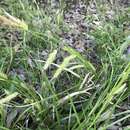Description
provided by eFloras
Plants with short-creeping rhizomes, forming dense colonies. Culms brown to chestnut at base, surrounded by remains of old leaf bases, but not conspicuously fibrillose; flowering culms 30–80 mm, usually longer than leaves at maturity, 1–2 mm thick, glabrous but finely scabrous within inflorescence. Leaves: sheaths glabrous, basal ones dark chestnut, grading to light brown and green on back, all bearing blades, sometimes very reduced in size on basal ones; sheath fronts brown-hyaline or membranous, darker brown and often red dotted toward apex; blades rigid, flat or channeled near base, 2.5–7 mm wide, glabrous but margins, edges of adaxial surface, and midrib of abaxial surface finely scabrous. Inflorescences: peduncles of lateral spikes slender, to 100 mm (proximal spikes) or to 30 mm (distal spikes), minutely scabrous; of terminal spike 3–20 mm, glabrous; proximal bracts much shorter than inflorescences; sheaths 10–75 mm; blades 1.5–3.5 mm wide. Lateral spikes 4–12, 1–3 per node; proximal spikes well separated, arching, pistillate with 20–50 perigynia attached 1 mm apart, cylindric, 15–45 × 6–9 mm; distal spikes androgynous or staminate, usually crowded near apex. Terminal spike staminate, sometimes compound at base, 20–60 × 2.5–4 mm; the set of predominantly staminate spikes usually conspicuously raised above predominantly pistillate ones. Pistillate scales pale hyaline tinged with light brown, with midrib green to golden green, ovate to elliptic, nearly as long as mature perigynia, gradually narrowing to acuminate or short-cuspidate apex, glabrous except scabrous midrib. Perigynia green to straw colored, sparsely red dotted, 2-ribbed and finely 7–10-veined, slightly inflated around achene, ovoid, 5–6.5 × 1.5–2.5 mm, membranous, base rounded, apex gradually tapering to beak, glabrous; beak bidentate, 2.5 mm including teeth, teeth hyaline, narrow, to 1 mm. Achenes substipitate, 2–2.5 × 1.2–1.7 mm.
- license
- cc-by-nc-sa-3.0
- copyright
- Missouri Botanical Garden, 4344 Shaw Boulevard, St. Louis, MO, 63110 USA
Habitat & Distribution
provided by eFloras
Fruiting late spring–early summer. Floodplain forests, mesic deciduous forests, wet clearings and swamp forests, stream banks, acid seeps, margins of sinkholes, dolomite glades; Ala., Ark., Fla., Ga., Ky., La., Miss., Mo., N.C., Okla., S.C., Tenn., Tex., Va.
- license
- cc-by-nc-sa-3.0
- copyright
- Missouri Botanical Garden, 4344 Shaw Boulevard, St. Louis, MO, 63110 USA
Comprehensive Description
provided by North American Flora
Carex cherokeensis Schw. Ann. Lye. N. Y. 1: 71. 1824
Carex recurva Muhl. Descr. Gram. 262. 1817. (Type from "Cherokee.") Not C. recurva Huds.
1778; nor C. recurva Schkuhr, 1801. Edritria recurva Raf. Good Book 26. 1840. (Based on Carex recurva Muhl.) Carex Christyana Boott, Bost. Jour. Nat. Hist. 5 : 114. 1845. (Type from Texas.) Carex baazasana Steud. Syn. Cyp. 236. 1855. (Type from Rio Brazos, Texas.) Carex brazasana Steud.; Bock. Flora 39: 321. 1856. (Correction in spelling only.)
Cespitose, the rootstocks stout, tough, elongate, ascending, blackish, covered with the persistent leaf-bases, the culms 3-6 dm. high, slender but erect, exceeding the leaves, strongly phyllopodic, obtusely triangular, smooth, except in the inflorescence, strongly darkened but not fibrillose at base; leaves (not bracts) usually 4-10 to a fertile culm, mostly clustered toward the base, not septate-nodulose, strongly striate, the blades thick, flat or channeled at base, light-green, long-attenuate, usually 1-2.5 dm. long, 3-7 mm. wide, roughened toward the apex, the sheaths glabrous, copper-brown-tinged ventrally, concave at mouth, the ligule very short; terminal spike staminate, usually with one or two additional smaller staminate spikes at base occasionally pistillate above, peduncled, linear, 2.5-6 cm. long, 2.5-4 mm. wide, many -flowered, the scales closely appressed, ovate-oblong, rounded on back, obtuse, whitish-hyaline with greenish or yellowish center; pistillate spikes usually 3-6, the lower often in pairs or even threes, erect or somewhat drooping, widely separate, the lower on long slender rough peduncles, the upper shorter-peduncled, oblong-cylindric, 1.5-4.5 cm. long, 6-9 mm. wide, containing 10-50 closely arranged appressed-ascending perigynia in several rows; bracts leaf-like, reduced upward, the sheaths long, the lower 2-8 cm. long, even the uppermost well-developed; scales lanceolate, acuminate, thin, greenish-white with green midvein, often somewhat brownishtinged, narrower and usually somewhat shorter than the perigynia; perigynia ovoid, 5-6 mm. long, 2.5 mm. wide, obscurely flattened, globose-triangular in cross-section, somewhat inflated, greenish-straw-colored, membranaceous, several-nerved, rounded at base, somewhat abruptly contracted at apex into a slender beak one fourth the length of the body, scarious and bidentate at apex, the orifice obliquely cut; achenes obovoid, 2-2.5 mm. long, 1.5-1.75 mm. wide, brownish-black, granular, triangular, the sides concave below, the angles prominent and lightcolored, short-stipitate, prominently slenderly (often bent-) apiculate, jointed with the straight slender style; stigmas 3, slender, long, reddish-brown.
Type locality: "Cherokee," and as given by Schweinitz and Torrey: "Hab. the Cherokee country. Mrs. Gambold."
Distribution: In the low country, Georgia to Texas, and northward to southeastern Missouri and Oklahoma. (Specimens examined from Florida, Georgia, Alabama, Mississippi, Louisiana, Texas, Oklahoma, Arkansas, southeastern Missouri.)
- bibliographic citation
- Kenneth Kent Mackenzie. 1935. (POALES); CYPERACEAE; CARICEAE. North American flora. vol 18(5). New York Botanical Garden, New York, NY
Carex cherokeensis: Brief Summary
provided by wikipedia EN
Carex cherokeensis, commonly called Cherokee sedge, is a species of flowering plant in the sedge family (Cyperaceae). It is native to the United States where it is found in the Southeast. Its natural habitat is in high-nutrient, often calcareous soil, in bottomland forests, mesic forests, and wet meadows.
Carex cherokeensis is a rhizomatous perennial graminoid. It has drooping spikes which are 8–9 mm thick. Its perigynium beaks are papery and fragile. It produces fruits in late spring and early summer.
- license
- cc-by-sa-3.0
- copyright
- Wikipedia authors and editors
Carex cherokeensis: Brief Summary
(
Indonesian
)
provided by wikipedia ID
Carex cherokeensis adalah spesies tumbuhan seperti rumput yang tergolong ke dalam famili Cyperaceae. Spesies ini juga merupakan bagian dari ordo Poales. Spesies Carex cherokeensis sendiri merupakan bagian dari genus Carex. Nama ilmiah dari spesies ini pertama kali diterbitkan oleh Schwein..

